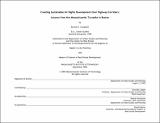Creating sustainable air rights development over highway corridors : lessons from the Massachusetts Turnpike in Boston
Author(s)
Campbell, Bonnie E., 1977-
DownloadFull printable version (3.553Mb)
Other Contributors
Massachusetts Institute of Technology. Dept. of Urban Studies and Planning.
Massachusetts Institute of Technology. Center for Real Estate. Program in Real Estate Development.
Advisor
Eran Ben Joseph.
Terms of use
Metadata
Show full item recordAbstract
Research and practice have shown that air rights development over highway corridors in America's cities is not only feasible, but desirable. As planners, policy makers and consumers attempt to curb the sprawling development pattern that was characteristic of the second half of the twentieth century, the development of the air space over urban highway corridors is emerging as a beneficial type of development that promotes revitalization and can be more sustainable than other types of redevelopment. As the advantages of air rights development over highway corridors become increasingly apparent, more projects and proposals are surfacing in cities nationwide. However, while this development pattern can contribute to urban revitalization, it is also unique from other types of infill and redevelopment. Air rights development is complex and requires special scrutiny and treatment from a planning and policy perspective, a distinct understanding of urban design and attention to neighborhood context, and specific development principles for construction and financial feasibility. This thesis describes these unique considerations both generically and through analysis of the Massachusetts Turnpike in Boston. It examines three cases: a completed air rights development, a planned development that has gone through the permitting phase, and a proposed air rights development as it seeks the path of least resistance for development. In this examination, a set of "best practices" and recommendations is proposed to advance the feasibility of this unique type of development. The recommendations aim to make air rights development over highway corridors more sustainable, more predictable, and more systematic in improving the urban environment. Chief among these recommendations include: the implementation of a robust and predictable regulatory framework to control the outcome of air rights development; design guidelines to ensure connectivity and contextualized development that also reflect realistic assumptions about financial feasibility and development intensity; and a systematic air rights lease negotiation process and framework that links leasing liabilities to future development revenues.
Description
Thesis (M.C.P. and S.M. in Real Estate Development)--Massachusetts Institute of Technology, Dept. of Urban Studies and Planning, 2004. This electronic version was submitted by the student author. The certified thesis is available in the Institute Archives and Special Collections. Includes bibliographical references (p. 111-115).
Date issued
2004Department
Massachusetts Institute of Technology. Center for Real Estate. Program in Real Estate Development.; Massachusetts Institute of Technology. Department of Urban Studies and PlanningPublisher
Massachusetts Institute of Technology
Keywords
Urban Studies and Planning., Interdepartmental Degree Program in Real Estate Development., Center for Real Estate.